For the revival of agriculture in Russia it is necessary to create a fundamentally new energy base infrastructure by using distribution of next generation networks, local and renewable sources of electrical energy. Distribution of the new generation network is proposed to establish at base of Energy Saving single-conductor resonant systems for rural electricity consumers under Nikola Tesla ideas.
Progress in material technology in wide-bandgap semiconductors, such as Silicon Carbide (SiC) enables increasing the operation frequency of high-voltage (HV) generators and using less series connected devices for the same voltage rating of the HV-generators. These generators are frequently equipped with HV multipliers, such as the Cockcroft-Walton cascade, a resonant inverter and a high voltage transformer. Power conversion at high frequency usually helps reducing the system size and cost and allows better efficiency at smaller size and lower weight. At high frequency and high voltage, however, the influence of parasitic effects of the multiplier, namely parasitic capacitance, becomes highly relevant to the feeding circuit. Experience from existing circuits indicates, that the total parasitic capacitance at secondary side is not only related to the HV transformer and the junction capacitance of the diodes, but also to the extension of the electric AC field in the rectifier circuit, which reflects the structural parasitic capacitance. It can happen that a substantial amount of driving current is required only for inverting the voltage across the parasitic capacitance, which puts a limit on the maximum useful frequency. In general it is to be expected that parasitic capacitance will increase with denser packaging of the components.
Modelling techniques of high voltage AC cables has been a subject to researchers as early as in the 1920’ies and research in the field continues steadily as cables become more complicated in design and more popular at higher voltage&frequency levels and for longer transmission lengths. In recent years, the interest towards using underground cables in power transmission has increased considerably. In Denmark, the entire 150 kV and 132 kV transmission network shall be undergrounded during the next 20 years. Even 400 kV transmission lines will be undergrounded gradually as more experience is gathered. Precise modelling of long and many (meshed) underground cable lines is therefore essential and it is important that differences between simulations and measurements are identified, studied and eliminated. A study of the cable model accuracy for transmission line modelling is the topic of the research documented in this thesis.
The resonant power supply system allows you to transfer electrical energy at any frequency, that will be the most optimal for the particular electricity transmission scheme. Traditional power system operates at a frequency of 50 Hz, which is controlled by automated system, and it leading to fluctuations in the system frequency power, and sometimes to full blackout. Like in the USA in 1962 year.
In 1950–1960 of the last century, Russian scientists have developed power systems with DC-inserts. They were built in Vyborg, Finnish Paste, Volgograd – Donbass 800 kV, projected insertion DC voltage 1500 kV Ekibastuz. Resonance High Frequency single-conductor transmission system has in its structure two DC link reduced by weight and size dimensions as electrical equipment and can transmit electricity at single-conductor lines with minimal losses. A big problem in the regional grid companies (DGC) is a power quality, because power generators are far away from the Consumer.
When comparing equivalent electric AC and DC transmission systems is that when certain (critical) length of the line of their total cost (plus a substation line) are compared, and when the length of the line is greater than the critical power lines PT becomes more economical. At present, the critical length of the air line is 600–800 km, and cable lines – 30–50 km. However, even if the length of the line is equal to zero, the so-called DC link – VPT (rectifier and inverter substations installed in one building) – can solve problems that, in principle, can not be solved using the AC power lines, for example, to connect the two AC systems operating asynchronously or even having different frequencies (the system 50 and 60 Hz, such as in Japan).
As an example, the Danish network is connected to the neighbouring networks through several HVdc and HVAC interconnections. These HVdc systems terminate close to each other and when all are importing power into Denmark, having multiple commutation failures for a single ac fault is expected. Under certain generation scenarios, the western part of Denmark is operating in what is called a “wheeling mode”, where some of the HVdc terminals in Denmark are operating as rectifiers while others operate as inverters. This situation can happen for example when power is exported to Sweden and imported from Norway at the same time. In this operation mode it has been observed that a commutation failure at the inverter side of the first HVdc link will propagate through its rectifier to the AC system at its sending end and eventually causes a commutation failure on the second HVdc link. Since the commutation process is a short term transient event, electromagnetic transient simulation is required in order to observe the commutation failure propagation phenomenon.
Materials and methods of research
It has been widely accepted that voltage source converter (VSC) based HVDC system using IGBT is the preferred DC technology for connecting wind farms due to its advantages of independent active and reactive power control, flexible AC system control and support which are particularly important for offshore wind farms. A number of VSC connected offshore wind farms have already been in operation, This work was supported in part by China Electric Power Research Institute and the State Key Laboratory of Alternate Electrical Power System with Renewable Energy. VSC based multi-terminal HVDC systems have also been developed, e.g. the three-terminal ±160 kV Nanao project with the converters rated at 200, 100 and 50 MW, respectively. On the other hand, the conventional line commutated converter (LCC) based HVDC systems using thyristor have long been used for bulky power transmission and proven to be superior to VSC systems for high power rating in terms of cost and reliability. A number of recently commissioned LCC-HVDC projects have DC voltages of up to ±800 kV and power capacity of a few GW, e.g. the 5 GW Yunnan-Guangdong HVDC link and the 8 GW Xiluodu-Zhejiang HVDC link. However, LCC systems usually require relatively strong AC systems to operate, and thus become problematic when supplying island networks, e.g. offshore wind farms. In addition, they require larger footprint than VSCs and thus are more difficult for offshore installation. Hybrid, waterproof coaxial cables are more cost-effective solution for such coastal consumers.
China Yunnan-Guangdong transmission system control and modulation scheme of DC system greatly effect on transient stability in AC/DC hybrid power grid. Taking Southern China Power Grid in the year of 2015 for example, when fault occurs in the sending system Yunnan power grid, influence of modulation scheme such as large power flow modulation and bilateral frequency modulation on transient stability margin of hybrid system is explored. Study results are available for reference in the programming and the making of DC modulation measures for ultra-high voltage Yunnan-Guangdong transmission system.
Results of research and their discussion
The new sample of the hybrid cable reduce technical losses in networks of DGC transmission of electricity at the lowest cost, reduce theft cases of electricity, electrical, ferrous materials, as well as to realize networking sites RAC (it has fiber optic lines) carried out the country’s energy policy by energy conservation. The resonant high-frequency electric power industry has a huge promising future, the more so that the power electronic components is constantly improved, it creating new materials that can withstand increasing tension and frequency. These system also need to be used with non metal cables that consist fiber optic lines. It has so many advantages to the final Consumers like communication, light weight of cable, resistance of a line, etc.
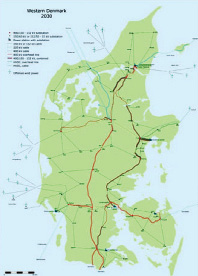
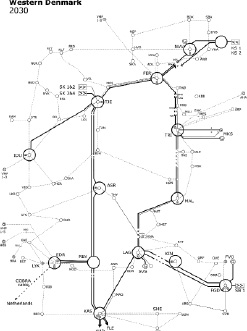
Fig. 1. Western Denmark network as planned for 2030 (including for agricultural consumers, source: Energinet.dk)
In the first stage of tests was tested with a copper conductor cable and cable results “BOGEKS-2” 100m length following test results were obtained (Table 1).
The next development was the cable “BOGEKS-3” in length 294m, and the following results were obtained (Table 2).
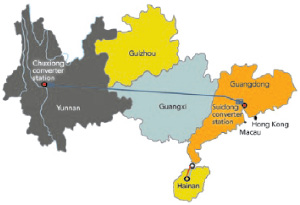
Fig. 2. Yunnan-Guangdong transmission system
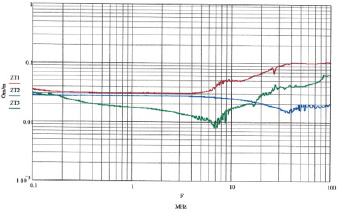
Fig. 3. The dependence of the resistance of the cable “BOGEKS-3” wire braid and frequency
Table 1
BOGEKS-2” results
|
Capacity |
12 nf screen |
|
Capacitance between conductors |
7 nf |
|
Capacitance per unit length |
70 pF/m |
|
The resistance of a conductor |
56 ohm |
|
The resistance of the two cores |
112 ohm |
|
The resistance per unit length |
1,12 ohm/m |
|
Screen Resistance |
125 ohm |
Table 2
“BOGEKS-3” results
|
Capacity lived |
53,7 nf screen |
|
Capacitance per unit length |
182 pf/m |
|
Conductor resistance |
48,5 ohm |
|
Screen Resistance |
11,1 ohm |
|
The resistance per unit length overall |
0,2 ohm/m |
|
The resistance per unit length |
0,57 ohm/m |
|
Screen Resistance |
114 ohm |
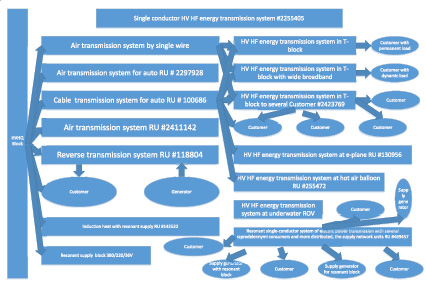
Fig. 4. Proposed scheme for Energy Saving single-conductor resonant power supply system via new cable infrastructure “BOGEKS-3”
It allows energy customer to create electrical equipment of new generation with small dimensions and weight sizes, meeting the modern requirements for quality electricity, electromagnetic compatibility, as well as the efficiency of electrical equipment. Thus, using (HVHF) single-conductor resonant systems will be solved by one of the electrification of the major problems, particularly in agriculture – the creation of a reliable electrical power for small villages, hamlets and farms and distant objects in the vicinity of water. The system is absolutely safe, in case of interruption, fault and short circuit. Will change the system capacity and people, aquatic life and the environment will not be affected, as it can occur when conventional systems.

Fig. 5
Using of hybrid cables at such systems is obligatory as communication is a modern society. Hybrid cable could be connected to variety of sensors as well. On this basis, it is proposed to use widely Energy Saving single-conductor system using resonant mode at high frequency power supply for rural consumers.
The system is able to create a much more perfect technological approach for energy transfer with structural scheme shown in Fig. 5.
The single wire power transmission system allows to create a variety of different technology options for Energy Saving Systems, as well as to solve engineering tasks of a quality power supply to an infinite number of variants electrical consumers. Justification of the block diagram of a resonant transmission system electric energy will start with creating a unifying and common for all on functional task of transmitting resonant system unit (PBRS). PBRS consist a rectifier with a filter that converts AC 50 Hz main voltage into a DC voltage, receiving power from a standard single-phase or three-phase electric network, or any other. Like renewable power source DC or AC. Renewable systems as modern equipment need to be used with a feedback and telemetry control line. These needs will be served by hybrid fiberoptic cable.
PBRS using the oscillating circuit, which includes a resonant Tesla transformer and capacitor unit connected through single-conductor hybrid coaxial fiber cable or air line and feeds all kinds technological electrical systems. PBRS has the ability to monitor the voltage in the resonant circuit in the line and also load, and control the operation of electronic switches with calculating the voltage across the load at the consumer would be standard. Air single-conductor line is designed for the transmission of electrical power from the resonance system to Consumer.
Thanks to its structural features, lighter poles with light insulators. As the small diameter of a hybrid wire its capacity per unit length is small and the line could be great length. Changes in the electrical parameters of the coaxial line due to weather accounted automatic PBRS. When open circuit or earth fault comes its electrical parameters and resonant mode changes and the line is de-energized. Terrestrial single-conductor line as intended for transmitting electrical power from the transmitting unit resonance system to the consumer. An other great feature of the cable line it is not deep laying in the ground needed.
When you open or short circuit come to ground it in the same way as the air line is de-energized than, but if for some reason it it does not happen, then the high-frequency voltage will not cause the stepper voltage, and will not have the damaging effects on human electrically current. On the one-wire hybrid cable BOGEKS-3 line do not affect the weather or flooding. Its only drawback – it is the linear capacitance, reducing the transmission distance.
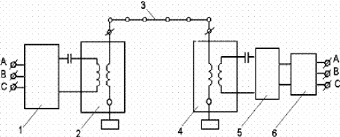
Fig. 6
Transmission of electrical energy with resonant circuit in the receiving unit is designed for consumers with a constant load. Adoptive block consists of Tesla transformer and the capacitor unit and operates also in the resonant mode as the transmitting unit. Due to its Functional features of the unit is designed for power supply with stable electrical load, such as a stationary lighting, electric motors, operating in a stable manner. A feature of transmission of electric energy resonant circuit is in the receiving unit that when changing load transmission quality factor changes, and changes load voltage.
Receiving unit with a broadband transformer used for consumers with a dynamic load, consists of broadband transformer, rectifier and filter inverter to a standard output voltage, which automatically maintains a stable voltage hybrid line.
When electric power transmission from the single-conductor hybrid line to several different users located at a distance and mutually dependent, foster unit maintains a stable voltage for each consumer. The resonant single-conductor power transmission network distributed multi-users and multi distributed supply network units operating in the resonant mode creates a standing wave in the line mode.
Generating stations distributed along the hybrid line, automatically create a network standing mode waves, allowing distributed along the lines of getting consumers electricity with fewer losses. The resonant power supply consists of a transformer with primary winding and the capacitor unit to operate in a resonant mode, and secondary winding to produce on request voltage.
Induction heating system with a resonant power supply and hybrid line allows using active and reactive currents in the inductive circuit, exploit the technological equipment more effectively agricultural enterprises, while saving energy, means for heating elements, being able to automatically to carry out the heating in wide aisles.
And as we know frequencies sufficiently lower than the surface plasmon frequency, the waveguide supports a plasmon polariton mode that resembles, and indeed reduces to the conventional TEM mode like of the conventional coaxial transmission line, known in the radiotechnology.
Conclusions
1. Energy Saving, single-conductor system, working in a resonant mode at high frequency for rural electricity consumers can create more perfect technological approach to the electricity transmission. China Picture Yunnan-Guangdong transmission system and Denmark system are good example. These systems need to be use with non-metal cables that consist fiber optic lines for a final consumer line.
2. Block diagram of the resonant power transmission system It demonstrates the possibility of Energy Saving, single-conductor of electricity and communication transmission and supply of various process equipment for agricultural purposes.
3. The resonant power transmission system with hibryd cable “BOGEKS 3” allows create a variety of different technology options Energy Saving Systems, as well as to solve engineering tasks the quality of power supply a large plurality of electrical load types.
4. The transmitting unit resonance system using vibrational circuit, which includes a resonant Tesla transformer, coaxial hybrid line and condensing unit, able to feed the electrical energy through Air or single-conductor cable lines all kinds technology electrical systems for agricultural purposes.
5. Aerial and hybrid cable lines are capable of single-conductor transfer with minimal loss of energy from the transmitter resonance unit to the consumer.
6. Transfer of electrical energy in the resonant circuit the receiving unit is designed for consumers with a constant load. Electric power transmission in a broadband transformer the receiving unit is necessary for the user with a dynamic load.
7. When electric power transmission through a single-conductor hybrid lines of multiple different users located at a distance and are independent of each other, foster unit automatically supports stable voltage for each consumer.
8. The resonant single-conductor electrical transmission network energy distributed to several users and several distributed power generating stations
9. Creating a standing mode wave line saves power and much secure, when transmitting through hybrid line.
10. The induction heating power supply system with a resonance It allows using active and reactive currents in the inductive circuit, more effectively exploit the agricultural processing equipment destination at cold regions.
11. The calculation of a transformer’s parasitics, such as its self capacitance, is fundamental for predicting the frequency behavior of the device, reducing this capacitance value and moreover for more advanced aims of capacitance integration and cancellation.
12. An open-ended coaxial line was used as a sensor in measurement of the permittivity of lossy dielectrics at radio and microwave frequencies. A simplified equivalent circuit related the permittivity to the measured input reflected coefficient. A more complete equivalent circuit is proposed and errors in the permittivity measurements resulting from the simplification are analyzed.
Resonant electric power systems with the use of single-line waveguide lines at high frequency are existed. The results of comparison of classical electrical engineering with resonant electrical engineering proposed by Nicola Tesla 100 years ago, are given. In such characteristics as current density and hybrid line losses, energy transmission distance, transmission capacity, the possibility of cable and wireless power transmission the Tesla electrical systems exceed the classical energy supply systems. The future world energy model based on solar energy and N. Tesla technologies for electric power transmission is suggested. The ten trends of the future development and application of resonant systems for electric power transmission are described. In future electrified mobile robots with external wireless electric power supply will allow to organize agricultural production on the principle “Industrial factories on the fields” with full automation of technological processes.

